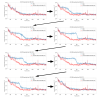It started at around 1:00 UTC.
I will search for coincidence signals later.
In a finer plot of GauCh, arch-like structures were seen at 50~100 Hz, and that the symmetric non-Gaussian width at 300~400 Hz seemed to widen (Fig.1).
Also, YamaT-san reported a bad sensitivity and noise in the PRCL signal at the same time (Fig.2).
In the following, I focused on the period from 3:25~3:40 (UTC).
First, the spectrogram of the PRCL IN/OUT data showed a structure corresponding to noise at 50-100 Hz, but nothing at 300-400 Hz (Fig.3). Therefore, I think the latter noise (300-400 Hz) may have another cause.
I also plotted ASD of PRCL every 30 sec, and Fog.4 is the example. With this plot, I confirmed that the staircase-like structure changed with time and this change corresponds to noise at 50-100 Hz.
The same structure was observed in K1:LSC-POP_PDA1_RF45_I_OUT_DQ, which is upstream of the PRCL (Fig.5). The figure was created with FFT=0.25 s, and even finer oscillations can be seen.
Next steps
I will examine other POP or REFL channels which is not used for control.
Interesting. For the arches, is it possible somehow reconstruct the original base frequency if this would be due to upconversion of scattered-light noise from wherever in PRC? Maybe starting with easy models would be enough...
Akutsu-san, thank you for your comments! We will try to do that, based on the paper of Virgo's scattering light (https://iopscience.iop.org/article/10.1088/0264-9381/27/19/194011).
Great job!
[Yuzurihara, Yamamura]
Abstract
Assumption
- This noise was caused by the scattered light.
- This noise followed the model in the above paper (https://iopscience.iop.org/article/10.1088/0264-9381/27/19/194011).
- The motion of the scatterer was a single vibration.
Then, the parameters of the motion were
- Amplitude: 14 [um]
- Frequency: 0.42 [Hz]
Details
By focusing on the 10 seconds from 3:30:00 (UTC), we focused on the structure of the finest oscillation.
The plot of Q-transform (Fig.1) was similar to Fig.4 in the paper, so we assumed the noise came from scattered light.
From eq.(3) in the paper, , the frequency of the noise corresponds to the absolute value of the velocity of the scatterer, and the velocity calculated from data is shown in Fig.2.
This figure shows that the maximum velocity of the scatterer was about 37 [um/s] and the period was about 2.4 [s]. Thus, the frequency was 0.42 [Hz]
Lastly, we assumed that the motion of the scatterer was a single vibration. In this case, the displacement x(t) can be written as
.
Then, the velocity is
,
which means the maximum velocity . Therefore,
Thank you for the analysis.
In fact, 0.42 Hz is very close to the well-known problematic L resonance of Type-Bp suspensions (around 0.44 Hz).
So, the result seems very reasonable.
I checked the feedback signals of PRCL on 19th and today (fig1 and fig2, respectively).
The y-scale is same for both ndscopes and obviously feedback signals (PRM motions) were larger on 19th.
So, it is very likely that PRCL suspensions moved a lot and generated scatterred light at that time.
There is a question about the meaning of "A", so I add some explanation.
In the paper of Virgo, means the velocity of the scatterer. So, I mean "A" is exactly the amplitude of a simple harmonic motion of the scatterer. (See Fig.1)
Therefore, the optical path length from the mirror to the mirror is
.
So, the maximum difference in optical path length is in my calculation.
Fig.1 is some plots of Q-transform during 6/19 1:34:00~1:34:10 (UTC).
You can see differnt structures depending on the channels.
By changing parameters, it looked both structures are seen in at least "K1:LSC_PRCL_IN1_DQ". (Fig.2)
In the model I used, the frequency of the noise corresponds to the velocity of the scatterer.
Therefore, the former structure, whose frequency got lower, means that the scatterer slowed down.
However, the latter structure means that it got faster.
I think it seems contradictory that these two phenomena occurred at the same time.
I selected several data which have noise from the scattered light randomly and checked the frequency of the scatterer.
It is the inverse of the period (eye measurement).
As a result, all of them were in the range of 0.42~0.44 Hz. It might mean all noise came from the same scatterer.
Thank you for the Interesting report.
For example, there are three suspended disparate PR mirrors (PRM, PR2, and PR3) having the same (but not identical) fundamental pendulum modes around 0.44 Hz. Here, although PRCL = Length between (PRM, PR2) + Length between (PR2, PR3) is locked, the each term in the right-hand side can move freely at the own characteristc frequency (in this case ~0.44Hz? but not necessarily identical) under the condition of the left-hand side (PRCL) being fixed. This would mean that the scatterors, (PRM, PR2, and PR3) can move independenty to some extent even when PRCL locked. So it would not be non-natural that one of the scatter is ringing up while the other one down might happen...
I summarized the results and my understanding in the document.












.png)
.png)
